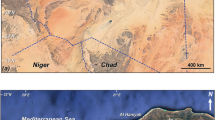Abstract
This study investigated the formation mechanism of dolines. Dolines are caused by dissolution of gypsum in the study area, 50–220 m in diameter. Two systems were applied to determine the support necessary for natural underground opening of given span in a given rock mass. From the characteristics of the rock mass, a 5 m-wide unsupported span in the gypsum can be expected to stand up for over 9 years. The designed span of an artificial opening would normally be considerably less than the span of a collapsed natural opening in the same rock. Dolines in the study area play an important role in the groundwater flow system.
Similar content being viewed by others
Author information
Authors and Affiliations
Additional information
Received: 10 November 1995 · Accepted: 4 January 1996
Rights and permissions
About this article
Cite this article
Karacan, E., Yılmaz, I. Collapse dolines in miocene gypsum: an example from SW Sivas (Turkey). Environmental Geology 29, 263–266 (1997). https://doi.org/10.1007/s002540050125
Issue Date:
DOI: https://doi.org/10.1007/s002540050125




